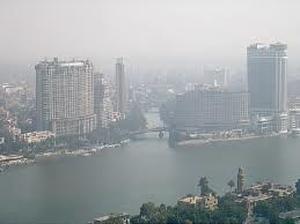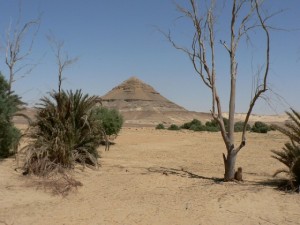Governmental Efforts for Greening Egypt
Egypt houses many ecosystems where diverse faunas and floras as well as human beings have coexisted in harmony. However, this biological harmony is endangered by many deteriorating factors: unmonitored industrial activities, soaring population growth, overexploitation and mismanagement of natural resources, inadequate investment in the agriculture sector, minimal environmental impact awareness among farmers, etc. In view of the steadily growing population and the industrial demands, environmental damages in Egypt will likely worsen which in turn will further plunge the economy. Although the Egyptian government has stepped up efforts to combat environmental degradation, yet these efforts are considered insufficient given the significant extent of the damages.

As a matter of fact, Egypt suffers from many environmental issues among which is air pollution. According to the WHO 2014 list, Egypt was ranked the sixth country – out of 91 sampled countries – with the most harmful air which causes many respiratory and cancerous diseases, especially in urban industrial regions. Air pollution is mainly attributed to old technologies used in many industrial activities, unregulated toxic factories fumes, open-air agricultural waste burning and car exhausts. The latter scourge reveals another alarming problem: Traffic congestion. On the one hand, enormous quantities of fossil fuel use, hazardous emissions discharge and noise pollution rise caused by the increasing vehicles number lead to serious health problems. On the other hand, relatively slow average traffic speed and long average commuting time cost the country its productivity and efficiency. This is reflected in the decrease of the Egyptian GDP by about 4%, mainly attributed to lost work hours, costs of fuel and poor workforce health.
Another environmental problem that the country faces is water pollution and scarcity. In rural areas, where sewage treatment facilities are almost absent, people throw their wastes in fresh water bodies. Every year, large amounts of untreated industrial and agricultural wastes and dead animals are thrown into the Nile or the sewage systems. Much of these wastes end up in the drinking and irrigating water which in turn contaminates food and beverages, and causes the spread of serious diseases. In addition, the problem of fresh water scarcity begins to surface due to overgrowing population, droughts, expected decrease in Egypt’s share of the Nile water after the Grand Ethiopian Renaissance Dam future full operation and water-wasting practices of some farmers. Concerning the salty water bodies, the ecological systems of the Red and Mediterranean Seas are endangered by unregulated coastal constructions, toxic industrial wastes disposal and unsustainable fishing practices. As a result, the Egyptian shores undergo coastal erosion, increased soil salinity, decreased fisheries production and marine life deterioration.

A third aspect of environmental degradation threatening the national food security is desertification: fertility loss of arable lands by losing their water supply which in turn decreases the lands ability to grow crops. Many factors are conducive to this undesirable phenomenon, inter alia, intensive cultivation, pesticides overuse, inefficient irrigation networks and seawater intrusion in coastal areas. However, the most crucial factor is urban encroachment on arable lands. In actual fact, Egypt is the most densely populated country in the Middle East with its capital Cairo, the largest Arab city. This intensive urbanisation compounds poverty and environmental degradation. Unfortunately, this large population does not enjoy sufficient green spaces that would help reducing air pollution and improving public health. For instance, while the minimal required green space is nine square metres per capita, each Cairene has only about 1.65 square metres.
All these environmental scourges undermine Egyptians’ health. Given the inadequate sanitation facilities in numerous settlements, many diseases have spread among Egyptians. A lot of schistosomiasis and typhoid fever cases have been reported. Besides, there is a high incidence of hepatitis A, B and C, kidney failure and cancer. The persistence of some diseases spread as well as the inefficiency of the health services network have brought back some diseases that were eradicated in the past. For example, some samples taken in December 2012 from sewage water showed the presence of poliomyelitis viruses which were once eradicated in 2004.
In attempt to combat environmental deterioration, the Egyptian government has taken many preventive measures. First of all, it has designated many bodies to deal with environmental issues. In 1997, Egypt’s first Ministry of State for Environmental Affairs (MSEA) was established. Other governmental bodies also shoulder the ecological responsibility, inter alia, the Egyptian Environmental Affairs Agency (EEAA), the Ministry of Agriculture and Land Reclamation, the Ministry of Electricity and Energy, the Ministry of Health and Population, the Ministry of Water Resources and Irrigation, and the Ministry of Local Governance. Concerning EEAA, it is the national authority for establishing environmental policies, implementing environmental projects and promoting environmental relationships with other countries. The local environmental authorities are the Environmental Management Units (EMUs) that supervise local environmental plans and projects in cities and villages. It is noteworthy that EEAA and the Ministry of Local Governance conduct environmental impact assessments (EIAs) for construction and engineering projects. They reject the eco-unfriendly projects and impose fines on polluting factories.
In addition, Egypt has promulgated many laws, adopted many constitutional articles and signed international conventions to safeguard the environment. As a matter of fact, Law Number 4 of 1994 is considered the main source of reference for environmental regulations, management and planning in Egypt. Nevertheless, the environment was first recognised in the constitution by the 2007 amendment of the 1971 constitution that added an article considering the environment protection a national duty. The 2012 constitution provided more environmental rights: right for « a healthy and undamaged environment », State responsibility to protect people as well as Egypt’s natural resources from pollution, etc. The 2014 constitution has included the citizens’ right to enjoy the recreational natural resources and the commitment of the State to adopt sustainable development policies, to protect the endangered species and to enable safe fishing practices. Furthermore, the constitution stipulates the State responsibility to further the scientific research related to water security and renewable energy sources. Moreover, Egypt has signed many international conventions and protocoles promoting environment safeguard, among which are the Rio Declaration on Environment and Development, the Kyoto Protocol, the UN Framework Convention on Climate change (UNFCCC) and the United Nations Convention on Biological Diversity (UNCBD).
Additionally, the Egyptian government has launched many projects to improve the quality of the environment. For instance, the Ministry of Local Governance has endorsed an initiative aiming to expand the organic fertilisers industry and to replace the imported chemical ones. By expanding this industry, the country will be able to export the organic fertilisers as well as to improve the public health, to impede soil degradation and to create job opportunities. Some projects, including the Jonglei Canal and the Northern Bahr al-Ghazal projects, were carried out to reduce water waste by preventing intensive evaporation. Besides, organic crops export rise is sought by other projects, among which is the East Owainat Project in the southern valley of Egypt. Regarding the MSEA initiatives and projects, the ministry has replaced thousands of old taxis and vehicles with new ones to reduce the air pollution and built the Gabal El-Asfar Wastewater Treatment Plant (GAWWTP) to serve the middle and lower parts of the east of Cairo.

The State has also sought solutions to defuse some specific environmentally harmful crises, among which are the overgrowing population and water scarcity. Since 1970, the government officials have tried to decentralise the living and working settlements out of the densely populated cities by constructing metropolitan areas in desert, namely New Cairo and Sixth of October City. Recently, the government had announced its plan to build a new capital city to counteract Cairo congestion and overpopulation. Nevertheless, the housing minister Mustafa Madbouly revealed later that the project will be financed by the private sector due to lack of governmental funds. Regarding the water scarcity problem, the Ministry of Water Resources and Irrigation has declared a state of emergency from May to August 2016 by banning water-thirsty crops planting in all farmlands except in some Delta Nile regions in the in the wake of a drought that has hit the African Horn. Farmers violating laws are liable to many sanctions: cutting off water supply to their lands, burning the illegal crops, etc. These water-rationing policies have proven to be inevitable, especially with regard to the Ethiopian Renaissance Dam construction that actually threatens Egypt’s Nile water share.
Although the Egyptian government has implemented many measures in order to decelerate the environmental damages, yet these measures have proven to be insufficient. As a matter of fact, the governmental economic policies still largely further profitability to the detriment of sustainability. The country still relies to a great extent on the costly and depletable fossil fuel instead of the renewable energy resources. Moreover, the lax enforcement of the environment related laws, the lack of investment incentives in eco-friendly projects and the mismanagement of natural reserves render these places vulnerable to the visitors misuse, indirectly incite harmful fishing and hunting practices, and exacerbate the pollution problem.
In order to optimise the environment related policies and measures, the government has to take into account many considerations. First of all, the tasks assigned for each governmental body dealing with environmental issues have to be described in the constitution to prevent vagueness and responsibility abdication. Secondly, the government should offer incentives to encourage private investment in eco-friendly projects and enforce the law to deter people from following environmentally abusive practices. Thirdly, the government ought to involve the citizens as well as experts in making decisions and shaping policies concerning the ecological worries by promoting public debates, raising public awareness about eco-unfriendly practices and allowing access to the information regarding environmental programmes and regulations.
In conclusion, Egypt has been plagued by grave ecological concerns: air pollution, water scarcity, contaminated food and drinks, desertification, coastal erosions, endemic diseases, etc. These aspects of environmental degradation have negatively impacted on the public health as well as on the country economy. To counteract these damaging effects, the government has taken various measures including establishing some institutions whose major role is promoting sustainability, promulgating laws to safeguard the environment, setting up eco-friendly projects and seeking solutions to face ecological crises. Nonetheless, these measures have turned out to be insufficient given the great extent of the challenges. Therefore, the responsibility of protecting the environment should be shouldered not only by the government officials but also by the grassroots. That is to say, all stakeholders have to cooperate in greening Egypt.
References (last visit on 4/8/2016)
- http://www.al-monitor.com/pulse/originals/2016/06/egypt-crops-water-crisis-state-emergency.html
- http://www.tadamun.info/2013/07/25/the-right-to-a-sustainable-environment/?lang=en#.V6K9HWWcFUs
- http://www.tadamun.info/2014/01/08/right-to-a-sustainable-environment-in-the-egyptian-constitution/?lang=en#.V6K4Q2WcFUt
- http://www.dailynewsegypt.com/2013/06/05/egypt-the-question-of-the-environment/
- http://www.ecomena.org/egypt-water/
- https://en.wikipedia.org/wiki/Environmental_issues_in_Egypt